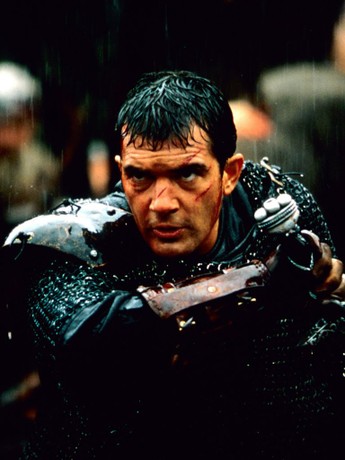On its 1999 release, this historical action film starring Antonio Banderas as an Arab warrior was a big flop. But now, it’s been rehabilitated – among Muslim fans in particular.
Released in the US 25 years ago today, The 13th Warrior had all the markings of a Hollywood blockbuster. It had an A-list star in Antonio Banderas, was helmed by renowned action director John McTiernan, known for blockbuster hits like Predator and Die Hard, and was based on a fascinating novel written by Jurassic Park author Michael Crichton called Eaters of the Dead.
Like the book, which was a loose reimagining of Beowulf, the movie told the story of Ahmad ibn Fadlan, a 10th Century Arab diplomat exiled from Baghdad, who reluctantly joins a group of Vikings in their quest to battle a mysterious and terrifying evil.
However, despite all that, it was a critical and box office failure. After costly reshoots brought on by negative feedback from test screenings caused the budget to balloon to well over a $100m (£76.2m), the film only grossed $61.7m (£47m) worldwide. Film critic Roger Ebert, giving it a rating of 1.5/5 at the time, wrote that the film “displays a lot of cash on the screen, but little thought. To extract the story from the endless scenes of action and carnage is more effort than it’s worth”.
But while it is long forgotten by much of the general public, the film has cultivated a devoted cult following, especially amongst Muslims searching for positive representation on the big screen.
Hollywood has been the subject of frequent criticism for its often-toxic portrayal of Muslims and Islamic culture over the years. It is quite telling that, even today, one would be hard pressed to find an example of a positive or nuanced depiction of a Muslim protagonist in a film but no dearth of villainous or problematic ones. There is the odd biopic about a significant Muslim figure such as Ali or Malcolm X, and a handful of comparatively smaller budget films with Muslim protagonists like Traitor and The Big Sick that buck the trend. Yet, none had the level of resources poured into them that The 13th Warrior did, making its underperformance even more stark and its legacy a complicated one.
“As someone who has spent 20 years trying to make movies and television shows that put Muslim identities at the forefront, I think The 13th Warrior probably hurt the situation because it was such a box office disaster that some people in Hollywood decided that they weren’t going to make a movie with a Muslim protagonist anymore,” says Dr Reza Aslan, a bestselling author, TV producer and professor of creative writing at the University of California, Riverside. “Then, almost immediately, we had the events of 9/11 which allowed Hollywood to turn Muslims into the antagonists.”
Its genesis from book to film
Now, 25 years after its release, the film warrants a reassessment, especially in light of its contribution to on-screen Muslim representation, at a time when having a Muslim protagonist is still pretty unconventional.
“Legend has it that Michael Crichton was arguing with a friend about the merits of Beowulf – the first important Anglo-Saxon work of literature – and on a bet decided that he could rewrite it for a modern audience,” says Aslan. “In the process of doing so, he stumbled across this manuscript by Ahmad ibn Fadlan that is the very first outsider’s description of Viking culture that we have – and was so taken by it that he decided to make him the protagonist of his story.”
According to Warren Lewis, an adjunct professor of screenwriting at California State University, Fullerton and one of the screenwriters of the film, when adapting the book into a movie, there was no doubt that the Islamic faith of the character was going to be a central element. In fact, a lot of thought went into presenting Ahmad in a tasteful manner, which is why the version of the character we see on screen is much different to earlier more comedic conceptualisations that were discarded.
It’s not difficult to figure out why many Muslim viewers gravitate towards him. Played with an air of quiet dignity by Banderas, while Ahmad is placed in a fish-out-of-water scenario with the Vikings, this is not used solely to ridicule him, as could have happened, but instead he is given plenty of opportunities to shine with his intellect and bravery. When the Vikings mock the size of his horse, he impresses them with how well he can ride it. When they give him a sword too heavy for him to lift, he fashions it into a scimitar he can wield with ease.
“Poor, confused Ahmad doesn’t know what he’s gotten himself into. He gets thrown a sword – a big old two-handed Viking sword – and is unable to pick it up. The joke is that he is told to grow stronger. And what does Ahmad do? He grows smarter. He finds a metal worker and makes it into a beautiful Arab curved sword that has more cutting ability than the club they handed him,” says Lewis. “Do you know that ‘Grow Stronger’ became a slogan amongst a particular unit in the United States military? It was even on patches. That moment resonated with a lot of people.”
Another moment that stands out is when the Viking leader enquires whether Ahmad could “draw sounds” (ie write), juxtaposing the scholarly Arab with the illiterate Northmen. To demonstrate that he can, Ahmad chooses to write, in Arabic, the Muslim declaration of faith: “There is no God but Allah and Mohammad is his Prophet.” It is refreshing to see it appear in a movie in a manner that is just educational with no sinister overtones whatsoever. “He could have written the men’s names or anything else, but he goes straight to what’s in his heart,” says Lewis.
“It was probably disorienting – but in a good way – for Western audiences to see writing and learnedness associated with the Arabic script and Islam, as opposed to Western cultures,” says Dr Lynn Shutters, associate professor of English at Colorado State University.
How it ‘reversed the Eastern’
With Ahmad being a practicing Muslim, the film avoids another trope that Hollywood perpetuates even when aiming for positive representation – he is a sympathetic person not as a result of him distancing himself from his faith, but because of it.
That’s not to say that Ahmad is only portrayed in a flattering light. He is initially sent away from Baghdad as punishment for an amorous encounter with a married woman – a big transgression for a devout Muslim. At the beginning of his character arc, he is judgemental, arrogant and vain – or as Lewis puts it “a bit of a dandy”.
“You have a man from an advanced civilisation who, for his sins, is banished to people that are involved in a horrible conflict he is not really qualified to fight. It’s almost like a space movie, or right on the edge of it,” says Lewis. “But even as an outsider, even as someone who wasn’t the most respected person in his hometown, [with the Vikings] he was always seen as the civilised man in the room. And, therefore, a Muslim from an advanced culture hanging out with these – what boiled down to – bikers.”
“It was interesting to have an Arab Muslim as our point of view character who was initially observing the Vikings and seeing how barbaric and uncouth they are in their behaviour, especially in the early part of the film,” says Shutters.
This dynamic wasn’t just a big departure from standard Hollywood depictions of Western enlightenment and superiority – which stretch as far back as the 1920s in films like The Sheik – it was almost a complete inversion of the tropes. Here was an Arab character separated from his culture, entering into an alternative Western world and then returning to “civilised society” a better man. Shutters refers to this as “Reversing the Eastern”.
The comradery and mutual respect that develops between Ahmad and the Vikings in the film is heartening. According to Lewis, The 13th Warrior was even shown in a class on unit cohesion at the US Army’s West Point military academy.
“One of the things I’m proud of in the film is that the Vikings never question his faith,” says Lewis. “They’re sarcastic and cynical – in every way bikers are – but they are right there with him.”
The inclusive nature of the Viking characters makes it more difficult for the film to be coopted by white supremacists, which Shutters cites as a significant concern when it comes to fictional portrayals of the Middle Ages. Despite Vikings being multiracial and multicultural, the Far Right have latched on to and weaponised a historically inaccurate whitewashed imagining of their history.
The criticisms that still hold
But while commendably avoiding some harmful tropes, the film is guilty of perpetuating others, perhaps due to the action-adventure genre it is situated in.
“One of the issues I have with the film is that it promotes a model of masculine violence,” says Shutters. “Even when presenting Ahmad positively as a learned man, there is a suggestion that he isn’t a ‘real’ man at the beginning, and he has to become a ‘real’ man by entering into the warrior culture of the Vikings. The fantasy behind this version of masculinity – that it’s necessary to be a warrior and a fighter because there are bad people out there doing bad things and you need to be militarily strong to defeat them – can be quite dangerous.”
There are also issues around authenticity that had perhaps been overlooked at the time due to the scarcity of any other positive Muslim representation on screen.
“I can’t divorce my personal feelings about the film – which I very much enjoyed – with the reality of what it’s like working in Hollywood today,” says Aslan, “because the lens that I used to go back 25 years to think about The 13th Warrior is one that can’t help but notice they had a Spaniard play an Arab; that it was fully written, directed, and produced by non-Arabs and non-Muslims. The process of making it and the finished product – as fun a movie as it was – was completely devoid of any authenticity.” He believes that were the film to be made today, Hollywood’s greater appreciation of the value of cultural authenticity would have meant Muslim involvement would have been considered a necessity.
The 13th Warrior is by no means a perfect film. But even a quarter of a century later, it remains a fun watch with an engaging storyline, great sets and costumes, and intense action sequences. Was it hard done by the brutal critical consensus at the time?
“Pirates of the Caribbean is a pretty good comp for what The 13th Warrior could have been,” says Aslan. “It had the same sense of swashbuckling adventure that became a ‘four quadrant’ movie that Hollywood is so desperate for – one that appeals to all age groups and demographics. I think if you made The 13th Warrior today, it would be far more successful because now you’d have a model to emulate.”
“I was really proud of my work on The 13th Warrior,” says Lewis. “It’s not my job to second guess critics, but I just can’t imagine what they were expecting. This was not science fiction, and yet it was. This was not a western, and yet it was. This was not a horror movie, and yet it was. So maybe they felt it was – as they say in Hollywood – a fish with feathers.” – BBC
By Mohammad Zaheer








